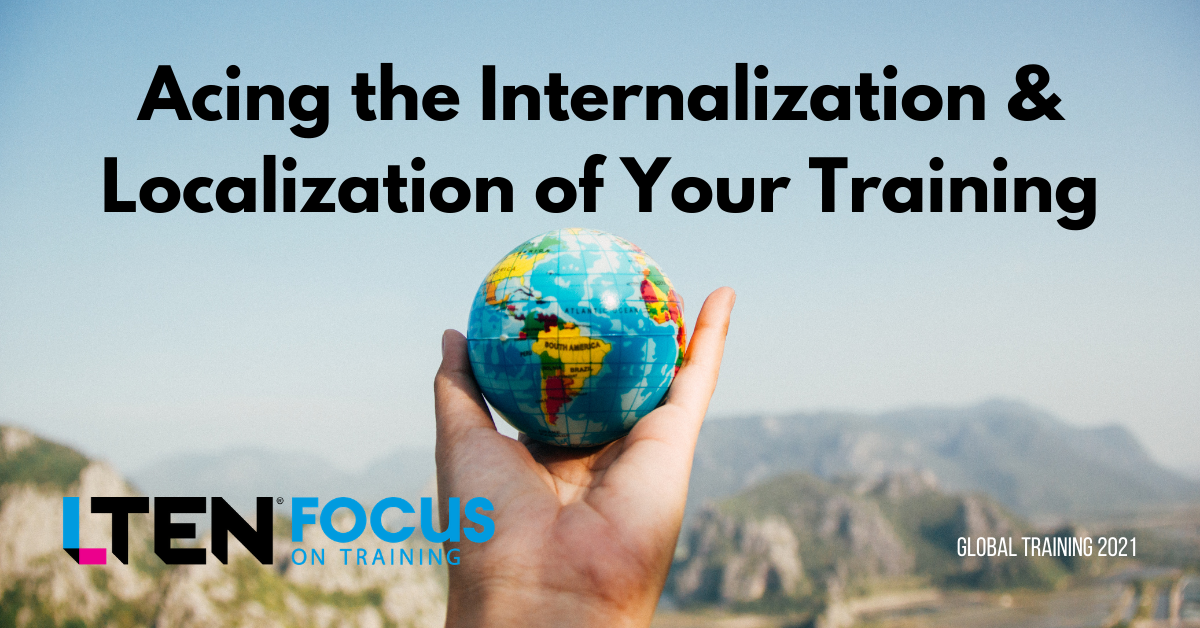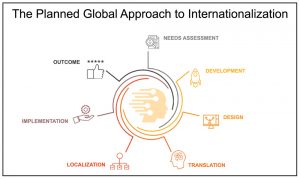
Acing the Internationalization & Localization of Your Training
Feature Story – By Todd Amrhein
Planning and care will make your international training stronger
Whether you are a global trainer or currently only train in the United States, it can help you to increase your awareness and understanding of international markets, and how training works in different countries.
At some point in your career, you may well be faced with an international project. It’ll help to know what to look out for and how to leverage content and international partnerships, increase collaboration, maximize training ROI, select the right agencies based on their experience and capabilities, create goodwill and enhance relationships. There is no downside!
This article is based on lessons learned – in the field and sometimes the hard way. International training is one area where an ounce of prevention is worth more than a pound of cure.
Pick Your Approach
There are basically two approaches to the internationalization process required to prepare your training materials for use in foreign markets: the much-preferred “planned approach” and the dreaded “ad hoc approach.” Let us have a look at both.
The ad hoc (global training as an afterthought) approach is typically used when a company, having already launched in the United States, decides later, down the line, to enter new foreign markets. The company uses the existing materials that it developed solely for the U.S. market and for an English-speaking audience, and simply has the materials translated for a specific country and used as-is, without further planning or adaptation.
The ad hoc method is short-sighted, costly, not strategic and can give results that are often disappointing. It lacks vision for global commercial success and is not the way to go.
The planned approach (see Figure 1) to internationalization is something entirely different. The planned approach is a process that is based on foresight, awareness and thoughtful planning. The company thinks strategically of going international from the very beginning, using what I refer to as the PATH Approach: Plan, Adapt, Think, Hats (yes, hats).
The Path
In this scenario, a strategic plan that takes several elements into consideration becomes part and parcel of your everyday training activities.
Plan your global approach from the onset. Basic planning for translation and adaptation of the content is a critical success factor, even if you are only involved in creating content for your domestic market, such as the United States. This is not hard to do when you know what to look out for.
Adapt: Once you decide to go global, adapt your training content for local regulations, language, culture and technology. Create content that is country independent (agnostic) whenever possible. Be respectful of regulations. Be considerate of cultural differences. Adjust design and technology for the company’s training needs and the availability of technology in the target country.
Think international throughout the process, from planning to the end. This will create efficiencies, trust and goodwill with your global colleagues. It will also foster a more respectful work environment and allow for easier training updates, saving your company money, and ultimately will give you more successful trainings and product launches.
Hats: Be ready to assume many different roles. The global community is incredibly diverse. You will learn so much while helping others to be successful in their jobs, which in the end helps you to become more successful and aware!
 Wear a Lot of Different Hats!
Wear a Lot of Different Hats!
The first time that you are made responsible for product launches in multiple countries, the task may feel overwhelming.
However, if you have local support and if you have an agency that has the necessary expertise and experience beyond your country borders, and your interest at heart, international training is quite enjoyable and a lot of fun.
You will be working with different countries and face different situations. Enjoy their cultures, languages, senses of humor and, yes, even their city’s architecture, museums, restaurants and cafes.
If you get the chance to fly into a country the weekend before your meeting, go out and explore, then open your meeting remarks by mentioning how much you enjoyed their country and learned over the weekend. You will have everybody’s attention and see a lot of smiles in the room. If you do this, and you follow the tips in this article, you will see smiles and results throughout the meeting, at the end of the meeting and beyond.
They say to understand someone, you first have to walk a mile in their shoes. My thought is you can also put on their hat. By doing so, you become one of them, understand their culture and needs better and can more effectively provide solutions for them.
Planning Your Global Approach
When considering the internationalization of your training, your plan should involve having a closer look at the needed steps and planning them from the start. The sequence in Figure 1 is not static and should be adapted to accommodate different project needs; nor are all of these steps required for all projects.
- Evaluate Training Needs: Define your business outcome. (I like using the 6Ds method.) Identify your goal and plan everything with that in mind. Will you be training teams outside of the United States? On which labels? In which languages? You must think from the beginning about what will have an impact on the training at every stage.
- Development and Design: Part of your training requires two very important steps when you consider exporting your training abroad. A planned internationalization of your training will require your training to be developed and designed a little differently. But that is precisely what will save you a lot of money, time and effort down the line.
- Localization Process: Make it easy for international colleagues to customize and localize. Graphs and images, for example, should be editable rather than static images, which are standard in most U.S.-based training materials.
- Translation Process: Accent-neutral voice talent should be used for videos. Yes, there are neutral accents in all countries and parts of the world. Will you use simplified Chinese or traditional Chinese if launching in China for example? There are significant differences you need to know before starting your translation.
- Implementation: How are you going to deliver your training for application? What methods (electronic requires a good wi-fi connection, paper, etc.), what structure, what is your timing, what requirements, limitations and cultural differences will you encounter in the different countries? Again, if the process is known from the beginning, you can be confident you will be delivering the best training no matter the country or language.
- Outcome of the Planned Global Approach: Document results (ROI) to be able to incorporate additional steps that you may not have considered previously, or steps that were particularly impactful in your next training.
These steps will maximize the use of your budgets, increase ROI and improve the impact of your international training.
Adapting Your Training
To better explain how to successfully adapt and internationalize your training, these items are grouped into four main categories: cultural differences, adapting content, regulatory adaptation, and design and technology.
1. Cultural Differences in Communications: We need to know how other cultures communicate to provide targeted content that will be well received. Differences in communication directly impact how one should present content, who presents it and how it needs to be structured. An excellent source of information on the subject is When Cultures Collide: Leading Across Cultures, by Richard D. Lewis
Cultural differences can affect communications and behavior in some of the most
unexpected ways:
- Power distance, for example, is much greater between employee and boss (and healthcare providers) in Asia and many other countries than it is in the United States. Power distance can be explained as the perceived distance between the boss and the employee. Some societies are more egalitarian (smaller power distance), while others are more hierarchical (larger difference between boss and employee).
- Expressing an opinion is done much more directly and easily in the United States than in Asia, where the path will often be more contextual. Some societies are high-context oriented, where meaning in context is implicit, the details come from the context and the listener is responsible for understanding the message (Asia). This can lead to misunderstanding for people from cultures that are low-context oriented, where the meaning in the message is explicit, the message contains clear details, and the speaker is responsible for ensuring the message comprehension (West).
Westerners often prefer to confront problems, whereas in an Asian culture, workarounds and avoidance may be preferred.
Regarding live (virtual) trainings, knowing how best to communicate with your audience will yield the results you want and expect. When you account for cultural differences, you provide training that is more efficient and much better received. It will create a lot more local goodwill and promotes much better retention of content, which in our industry can be quite complex and intimidating.
2. Adapting your Content
- Know Your Audience: Create content directly targeted for them. For example, know when to use British English vs. American English. Most of Europe, Africa and Asia are used to British English and may appreciate your planning for that and implementing British English into your materials.
- Utilize the Expertise of Your Agencies: Use agencies that are proficient in global training. There are other very solid agencies out there. An agency with the right track record, know-how and responsiveness can guide and partner with you to ensure your success. Your agency should have and make use of a comprehensive global training checklist, both as an ongoing reminder and to ensure that nothing is overlooked.
- Create Clear and Concise Content: This will save time and money down the line. Avoid acronyms, colloquialisms and idioms (like the verb “acing” used in the title of this article!) in both written and spoken English.
- Local Epidemiology and Prevalence Slides: Consider leaving a couple of slides empty as templates to be used to include country-specific information and/or graphics customized specifically for the local audience.
- Translation: Translation quality is important when materials will be translated into another language. Back translations are costly and problematic. I therefore prefer the use of a glossary to ensure accuracy and consistency throughout. This saves time and money. Have the glossary approved by your in-country medical personnel and get their buy-in. Then have all translations aligned to your glossary.
- Proper Variant of Local Language: Make this effort; it creates goodwill. An example is Castilian vs. Mexican Spanish depending on targeted market. Also, use accent-neutral narrators when recording materials.
- Specialized Translators, In-Country Reviewers and Interpreters: They should be experts in medical translations. They will provide native quality and accurate medical texts. Give translators access to your training materials and presentations in advance of the meeting. Speak with any interpreters before the meeting to go over difficult-to-pronounce words.
3. Adapting to Regulatory Environments; the Importance of the Label: Different countries around the world use different labels when they launch. They are usually based on either the U.S. Prescribing Information (PI) or the EU Summary of Product Characteristics (SmPC). To successfully plan and implement your training, you will need to know which label is used.
When offering training internationally, your company is liable, so your training should be customized to be as closely aligned and compliant to the local label as possible, if not the exact label for maximum impact. Emerging market countries typically use whichever EU or U.S. label is more generous in the approved indications and less ominous in the important safety information, while other countries with large government infrastructure may create their own labels and impose their own regulations.
Anyone involved in facilitating training in different countries around the world should know the differences between labels. This helps the facilitator remain compliant and minimizes confusion. Creation of a label comparison would highlight those differences and will help you see what you can reuse and what you must modify. Share it with your regulatory colleagues. They will love it!
Label comparisons are also useful at international medical conferences. Company employees will be better prepared to answer questions from doctors from different countries, armed with knowledge that directly relates to their country of practice.
Some countries have local labor laws and unions that regulate aspects of your training. In Argentina, for example, unions restrict the number of training hours in the day. Also, practice verbalizations may not be overheard by anyone other than the employee’s manager. Be prepared to step outside the training room and not listen in.
In France, continuing education is a government mandate, rigorous testing occurs on a yearly basis and testing materials are subject to regulatory agency audits. In Germany, training can be in English but testing and certifications often need to be German, and the same is also true in France.
Regulations and requirements can change rapidly, so make sure that you do your homework!
4. Design & Technology
- Local Internet/Power Availability: These conveniences may not be available everywhere, reliability may be an issue, bandwidth may be limited. You should plan and be ready with a backup solution. Never assume that “modern” cities around the world will have good wi-fi. Have paper backups always!
- Trainee Testing for Retention: Trainings will often include quizzes to help with knowledge retention. Should you use paper or electronic? If you choose electronic, consider making training available on a platform that does not require internet, in which materials are downloaded prior to the meeting. Customs sometimes confiscates items like iPads and other electronic devices. When shipping electronics, consider that boxes may be stuck in customs for days or even weeks. Have paper backups ready to go.
- Training Efficacy and Feedback: Companies can choose to use data collected from quiz results and surveys to obtain trainee feedback on the training. Make sure you obtain data on the ROI on your training. It will ensure your next training will be better and your personal performance is enhanced. Oh, and did I mention paper back-ups?
Think Global From Initial Planning to the End
Use the above methodologies and plan for and think about every aspect of your global training event (or collaboration with global trainers) in advance. Make sure you adapt your content for local markets, in consideration of cultural and regulatory differences. You’ll create efficiencies, trust and goodwill with your global colleagues.
It also fosters a more respectful work environment and allows for easier file management and training updates, saving your company money, and ultimately gives you more successful trainings and product launches.
Do this well and you will succeed.
Todd Amrhein is regional director, west for Akcea Therapeutics. Email Todd at
tamrhein@akceatx.com.









